Episode #416: Making Durable Decisions in Math Leadership | A Sustainable Math Practice Case Study
LISTEN NOW HERE…
WATCH NOW…
Fidelity matters, yet rigidity can stall growth. In this follow-up episode, we revisit the balance between fidelity and flexibility in math improvement and explore how two district partners faced this exact challenge.
You will hear how they committed to implementing with fidelity, ensuring consistency, clarity, and shared language, while avoiding the trap of rigid adherence that stifles innovation and teacher agency. Drawing from Janice Fraser’s Farther, Faster, and Far Less Drama and her leadership motions, we highlight how leaders can apply these ideas in real math contexts.
Listeners will learn how to:
- See why fidelity builds consistency, shared language, and measurable impact.
- Recognize where rigidity creeps in—like over-policing or “book says so” practices.
- Apply Fraser’s leadership motions (Orient Honestly, Leverage the Brains, Value Outcomes, Make Durable Decisions) to math initiatives.
- Anchor to outcomes like fluency, reasoning, and discourse rather than rigid scripts.
Tune in to see how fidelity fuels traction while flexibility keeps systems responsive to student and teacher needs.
Attention District Math Leaders:
Not sure what matters most when designing math improvement plans? Take this assessment and get a free customized report: https://makemathmoments.com/grow/
Ready to design your math improvement plan with guidance, support and using structure? Learn how to follow our 4 stage process. https://growyourmathprogram.com
Looking to supplement your curriculum with problem based lessons and units? Make Math Moments Problem Based Lessons & Units
Be Our Next Podcast Guest!
Join as an Interview Guest or on a Mentoring Moment Call
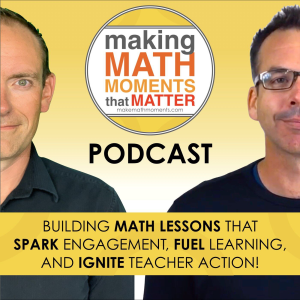
Apply to be a Featured Interview Guest
Book a Mentoring Moment Coaching Call
Are You an Official Math Moment Maker?
FULL TRANSCRIPT
Yvette Lehman: In Monday’s episode this week, we talked about this idea of fidelity versus rigidity. And today we’re just going to share some examples from districts that we support conversations we’ve had in the last week where this big idea emerged.
Jon Orr: Right, right, so quick, you know, a quick summary of that Monday. If you have not yet listened to the Monday episode or the Monday that, or the episode that was right before this one, you can pause if you like. And we talked about the theory here. We did some digging in, some learning from a book called Farther Faster and Far Less Drama from Janice and Jason Frazier. They unpacked kind of four big ideas that we talked about in terms of leadership and trying to address the issue of how much rigidity should we be trying to stay with when we’re talking about fidelity to a curriculum resource or fidelity in the classroom. They unpacked, orient honestly, leverage the brains, the people in the classroom, think about your outcomes, value those outcomes, make sure you keep them at the forefront and make some durable decisions. So we unpacked those four, go back and listen if you haven’t. But Yvette, I know that you wanted to talk about some examples from our district partners, the teams that we meet with every day, every week, every month, all year long to support them on their math improvement planning process. We talk about the process through our four stage journey. Let’s unpack the learning here on this idea of like how, if we want fidelity to the resources that we’re striving for and all of sudden rigidity’s creeping in. what can we be doing here? Let’s talk about these examples, these teams that we’re like, we noticed a little bit of maybe this going on and we had to kind of guide them in the right way.
Yvette Lehman: Yeah, actually our first one’s success story. It was a district who was willing to pivot. And I think the reason that they were willing to pivot is because they were clear on their outcome. So we talked on Monday about like not being rigid when it comes to the plan, but unwavering when it comes to the outcome, the change that they were hoping to support. So I’ll tell you that the outcome that they’re hoping for is, you know, equitable access to rigorous tier one instruction. Okay, so that’s what they’re striving for within their district. They want to create more cohesion across classrooms and across buildings, and they want to really ensure that teachers have mastery of the curriculum and have a really good understanding of what does mastery of each standard look like at their grade level. So the plan, so that’s the outcome. The plan was to optimize PLCs this year. So it’s like they identified that one of their subsystems that was not being well utilized was the PLCs and they wanted to strengthen the PLCs to help them get close to this outcome. So in the summer, they brought all of their teachers together and they actually engaged them in like a standard internalization process. And the process we had co-constructed together in the spring. So this team and I came together and we talked through like what might the protocol look like if we’re coming together during a PLC and the purpose is like this rigorous tier one instruction, mastery of the curriculum. We want to deeply understand what these standards look like if they’re proficient. So we had developed a protocol that was like, you know, what is the learning goal? What is the success criteria in our high quality instructional material? How is this being assessed? We were anticipating. You know, we identified one question from that assessment that we thought was a good example of mastery of the standard. And we were going to anticipate what students were going to do in response to that question and then do like a formative assessment cycle and bring the work back and then unpack it. And so, you know, they did this rollout in the summer through their professional development days. So that’s where we talk about like aligning all of your systems, right? So you have your pull-out PD days, you have your PLCs, you have your coaching cycles, and they’re all working on the same outcome. and the plan was to support the implementation of this protocol. Right. But this particular protocol was not selling very well in one division. Like it’s, it’s like, right. Like it’s like, like people didn’t want to do, like it’s like there was some resistors. They weren’t necessarily seeing the value. And so that team, this division came back to them and said, Would it be okay if instead of this protocol, we use, we adapted DoFOR’s work around the four PLC questions, which is like, what do we want students to learn? How will we know if they’ve learned it? What will we do if students have already learned it? Or what would we do if students haven’t learned it? What will we do if students already know it? And what do you think their answer was? Sure. Because like the outcome that we want isn’t going to be, it’s not the protocol. That is like the rigid part.
Jon Orr: Right, so what was the protocol, what, maybe they didn’t give you the details specifically, like what, like obviously they made the pivot to a new protocol to achieve the same outcome, which is what we want. Like we wanna be able to do that, we’re not stuck on the way, we’re stuck on the end. So that makes sense, but it’s, okay, fill us in, fill us in.
Yvette Lehman: Right. Right. Yes, I know what it was. I know what it was. Yes. The problem was the curriculum had already done a lot of that work. So they were just almost like copying and pasting it. Like the questions that we were asking through the protocol that we had co-constructed, it was like they were basically just like copying and pasting those answers from the standards and from the curriculum. And there wasn’t any thinking. And then it was kind of like, now we’re done.
Kyle Pearce: Sure. Now it became a checklist and ultimately it’s like now we’re falling off the path of why we’re doing this in the first place, right?
Jon Orr: it was too monotonous. Yeah.
Yvette Lehman: Exactly. Why we’re here. Exactly. So, and like, this is the thing. It’s like the team wasn’t rigid. Like, yes, we want a protocol. Like, absolutely. Like the PLC needs to have some type of structure and we need to have facilitation of the PLC. But what I thought this group did really well, it’s like they remembered the outcome. Right? So the outcome is they want this rigorous tier one instruction, which means that teachers need to have depth of knowledge when it comes to the standards that they’re teaching. They want to leverage the PLC to unpack standards. And it’s like, it’s, it’s not this protocol or that protocol or this wording or that wording that’s going to make the difference. It’s about establishing that culture of learning where teachers are digging in. And so if the barrier is the protocol, change the protocol.
Kyle Pearce: Hmm. I don’t like it.
Jon Orr: And they could only and so if you think back to some of the recommendations from our Monday episode, one of the big ideas we talked about was valuing the outcome over the process and making sure that it sounds like you’re saying this is success. This team did that. They said we know what the outcome is, we’re fine to pivot, we’re not we don’t need to like, my, we’re gonna go back on our word. We’re fine to do it because we were so clear. on the outset of what we’re doing. And they’re also doing one of the other elements of those four pieces. They’re leveraging the brains. They’re saying, we’re gonna trust what’s happening in this group right here and then we’re gonna leverage their expertise and what they’re looking at and going like, yes, they’re pushing back on this structure, but we’re all still agreeing that the outcome is important. So let’s move down this pathway and we’re gonna leverage those brains to make it happen.
Kyle Pearce: Well, and I think it’s worth highlighting, you know, when you look at the protocol and this is true for essentially any protocol, the reason we’re putting the protocol in place is to try to remove any sort of hurdles or challenges in helping you get to the outcome. So basically by swapping out a protocol that actually feels easier, feels smoother for that group, it makes a ton of sense that, you know, they’re open. with that idea because it’s like, well, does it help us get there? We asked the question, does it help us get there more efficiently, more effectively? Yes. All right. Like, let’s do it. Like, if everyone’s feeling really good about that or if, let’s say, the other protocol feels cumbersome in comparison, that could actually give you the opposite result, right? Where now people are actually becoming discouraged and, you know, they’re going like, I got to do this thing, but I don’t feel like that part’s actually worth it or I don’t feel like I’m heard. I feel like I’m not having any sort of autonomy. I think this is a perfect example where the autonomy gets to still live and it’s encouraging your brains, leveraging the brains to be thinking, to help you with this planning process, right? So that they’re the ones kind of doing some of the thinking and going, you know what, what about this? And you get to go, you know what, that’s a great move. And now maybe there’s two protocols that might work for other groups of educators, right? They might like one over the other. And as long as it helps them get to that same outcome, it makes perfect sense here. I love this example.
Jon Orr: Yvette, you mentioned there were two.
Yvette Lehman: Yeah, I had another call with a leader who was planning for a professional development session. And so the professional development session was going to be for middle school teachers. It was conference style, right? So this was one session throughout the entire day of sessions, but it was around the implementation of number talks in the classroom. And going into this conversation, you know, my and we’ve talked, we’ve done a whole episodes about how, you know, my own interpretation of number talks or fluency routines has evolved over many years. And so I knew that they were using a particular resource that I had used about 10 years ago to support the implementation of number talks within their classrooms. And so, you know, I asked, started by asking the question, like, what does this look like? Like when you facilitate, cause we were trying to come up with the learning outcome for the session, we were like, what do want teachers to walk away with? And so one of the things I asked is like, describe for me what this looks like. Like when you model a number talk, for teachers or what are the observable behaviors? know, and I was saying when I first started this work, it’s like kids were quiet. Nobody was talking until I called on the one student who put their hand up. They had nothing in their hands. There was no way for them to model their thinking and all these things. And so as our conversation went on, you know, we started to have a debate about what a number talk does look like. And I think that I wanted to be super clear with this leader and with our listeners today. I don’t think there’s one way to facilitate a number talk. Like I think there are different ways for different people, for different students, and there can also still be a baseline and some cohesion that exists. But I was saying things like, you know, when I first started number talks, I had nothing in their hands. Now, when we’re first developing the strategy before students have automaticity, I let them have a whiteboard. And this helps me select in sequence who’s gonna share their strategy for that day. And this was new learning for the person that I was on the call with. And the person kind of their response was like, we’ve been telling teachers nothing in their hands. And we’ve been telling them that for five years.
Kyle Pearce: So that’s like to me a crystal clear example, not uncommon by the way, but crystal clear example where the protocol, the actions we’re asking people to do has been disconnected from the actual outcome because you’ve always just felt that that’s the way it should be. But if you really think about that and you say, does that help or hurt? It really depends on what the outcome is that you’re looking for, right?
Jon Orr: Or they had a different outcome than what Yvette’s outcome is.
Yvette Lehman: Absolutely. And I think that that’s why I was trying to be careful in saying I don’t know that they need to look any one way. I think depending on your outcome or the goal you have. And I tried to explain, for me, it’s like, absolutely, eventually, I want them to have automaticity and I want them to be able to hold that model in their head. Absolutely. That’s the goal. They shouldn’t have to still have the rec and rec or the counters in front of them or the open number line drawn forever. I do want to move towards like they can actually visualize it in their brains. But for me, it’s like when they’re first learning the strategy and learning the model, think, you know, actually manipulating it or holding some information from the question on your whiteboard is helpful. But I think that why this idea of fidelity versus rigidity came to my mind during that call is like how often we do this in education. It’s like the book said to do it this way. So now we’ve rolled it out. We’ve rolled it out for five years and we’ve spent a lot of time getting everybody to do this thing the way the book says to do it. And now we’ve had new learning and we are hearing new ideas and maybe our outcome is becoming more clear and we want to make some adaptations, but we feel maybe stuck.
Jon Orr: Right. Yeah. So do you feel like this leader in the conversation had the epiphany that we’re like, okay, so we’ve been going down this and we’ve been saying nothing, but now like, do you feel like they were like, that’s a good reason to have that tool. And now they’re wondering like, what do I do now? Like is that, because one way you’d be like, well, I still disagree that, you know, like they could have held their stance, you know, like, so it sounds like they were convinced the way that you’ve evolved, that they were like, okay, that makes sense. You’re right, we’ve been doing that for five years and now I need to like, go back on my word.
Yvette Lehman: think they were certainly, you know, they’re a learner and they want what’s best for kids. And of course, like they’re open to hearing. And I think I was, you know, trying to be cautious and I am on this episode as well. Like this is my way that’s worked for me. It doesn’t mean that it’s the only way. It’s just my own learning journey and how I would approach this.
For sure, like I think the person was saying that makes a lot of sense. And they said, know, and I shared that like the work that I’d done had been around Kathy Fosno’s work and I’d implemented mini lessons for many years and that’s a tool and they weren’t familiar with that resource. So like, you know, her reaction was like, I’m gonna get a copy of mini lessons and I’m gonna try some and I’m gonna see how they’re different from what we’re currently doing and maybe, but I think there was fear, like fear of. we’ve been saying this is how you know this is what it looks like sounds like we’ve been maybe in in hindsight and maybe this is just my interpretation maybe we were rigid in some ways about what the implementation looks like and man what’s the pushback gonna be when i come back around
Kyle Pearce: Yeah, this is that idea. We talk about the beliefs loosely held. And I think it’s hard, because when you are rigid, the more rigid you are, the more you almost feel like you have to go to war and battle to defend why you might have done it in the first place, right? Because now it’s starting to make it seem like, maybe I didn’t know what I was doing, or something like that. Whereas I think this whole discussion hopefully gets, especially those that are trying to help districts and schools move towards certain, you know, certain goals of vision and through different protocols that we might use is we have to just be cautious on how firm we are with some of these pieces because you might maybe learn something new at some point that maybe you didn’t recognize earlier, right? So you had best intentions and maybe there’s a plan to shift over time. And I think we have to be very aware of that, that sometimes the harder we dig in, the harder it is to get out of that hole. And that can put you in a really tough spot as well.
Jon Orr: What do they do now?
Yvette Lehman: That’s a great question. And that’s why I needed to do some learning myself. You I was like, how do I support a leader who’s found themselves in this situation? And I think it does go back to, and we’ve said it again, like, we just need to be clear on the outcome. Right. And if the outcome is, you know, we want to build student strategic competence, we want them to have strategies and models that they can leverage as tools for thinking to increase their efficiency, flexibility and accuracy when working with all four operators, if that’s the goal. And a teacher does want to adapt and use whiteboards because they’re like, it’s, my students can then hold the information easier. They can see it more visually. They’re interacting with the model so that they can own that model. I think what we have to do is be okay and allow that adaptation or innovation to happen. And allow ourselves as well, like be okay that like we are also in an iteration of the implementation of fluency routines. And that means refinement. That means reflection. That means opportunities for.
Jon Orr: Right. And I think those can be the talking points to go when I do have to go back and let’s say I have to run in my professional development session and when someone teacher a teacher all of sudden says, but wait, you’ve been telling me this for five years to not do that. Now you’re saying it’s okay. That’s those are the talking points to bring forward. You know, I’ve been I’m loosely holding these strong beliefs. I’m celebrating adaptation. I’m I’m making sure that we’re you know, working on iteration. and it’s all for our better learning because we’re anchoring to the why, which are those four recommendations we talked about in the previous episode of what we can do as leaders even after the fact. So I find myself in this position, I can have the talking points to be able to like move forward, you know, into this tough discussion or this tough situation that you may find yourself in, but also know this is the way I’m gonna lead from now on in the work that we do. So if you are… So again, those guiding principles specifically are anchor to the why. Like what are we trying to do? Make sure that we’re sticking to our outcomes. We talk about that in the work that we do. It’s one of the important stages of establishing our vision, our objectives, our key results. What are we really trying to achieve? What do we want those outcomes to look like by year end, by six months in? Be clear on what you’re trying to do. Anchor the work you’re doing to those outcomes, those expectations. Expect iteration in the work that you’re going to be involved in because those cycles are going to be important and then celebrate the adaptation that comes from it and then support the bridges support those folks that are carrying that vision carrying the why into situations PLC staff meetings Coaching coaching situations coaching calls with with their the teachers they’re supporting those are the four kind of principles when you’re thinking about you know structuring PD and structuring support for teachers to make sure that we keep that, you know, the creeping rigidity, you know, off our backs as we, as we go through this type of learning with our our with our teachers and our principals and the people that we’re surrounding ourselves with, and also our students. If you’re looking for guidance, you know, on your vision, your expert, you know, your outcomes, your your key results, the work that you want to be doing, you’re not sure exactly if you’re planning To go down and hit those those results by the end of the year then Consider hopping on a call with us We could talk about our four-stage process that we help our teams go through So that they can get to the end of the year and say hey, these are the things we did and here’s exactly how we achieved those goals And here’s the evidence that I have to make it happen to made it all happen So we do that every day hop on that call head on over to make math moments comm force that’s discovery We’ll see you the next episode
Thanks For Listening
- Book a Math Mentoring Moment
- Apply to be a Featured Interview Guest
- Leave a note in the comment section below.
- Share this show on Twitter, or Facebook.
To help out the show:
- Leave an honest review on iTunes. Your ratings and reviews really help and we read each one.
- Subscribe on iTunes, Google Play, and Spotify.
DOWNLOAD THE 3 ACT MATH TASK TIP SHEET SO THEY RUN WITHOUT A HITCH!
Download the 2-page printable 3 Act Math Tip Sheet to ensure that you have the best start to your journey using 3 Act math Tasks to spark curiosity and fuel sense making in your math classroom!
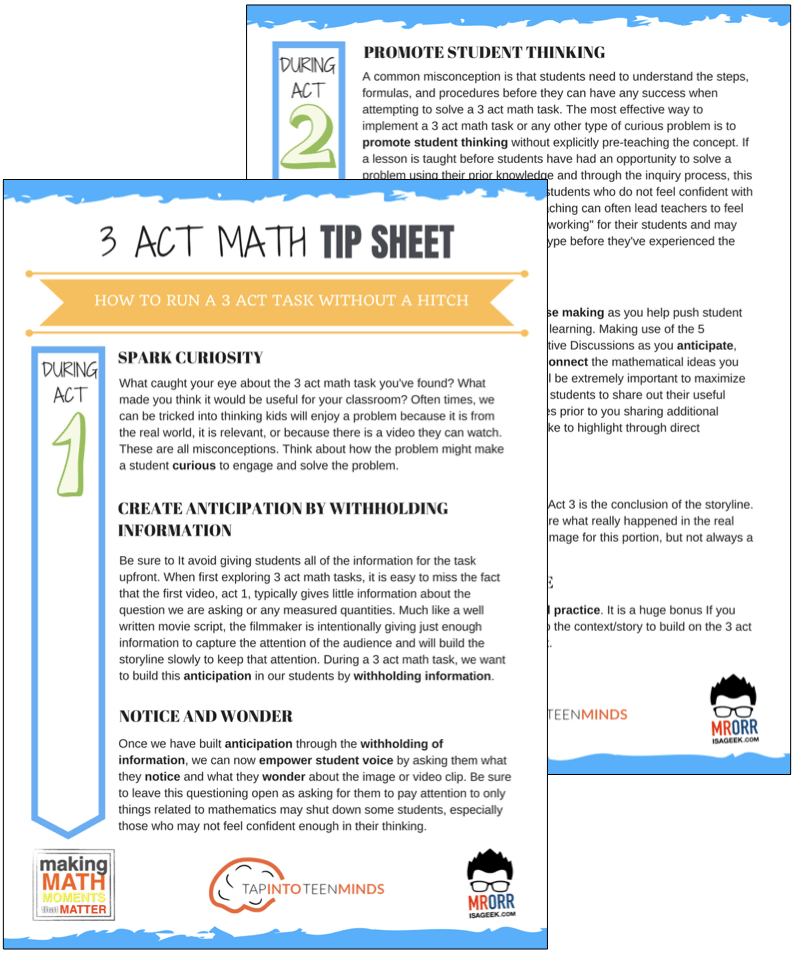
LESSONS TO MAKE MATH MOMENTS
Each lesson consists of:
Each Make Math Moments Problem Based Lesson consists of a Teacher Guide to lead you step-by-step through the planning process to ensure your lesson runs without a hitch!
Each Teacher Guide consists of:
- Intentionality of the lesson;
- A step-by-step walk through of each phase of the lesson;
- Visuals, animations, and videos unpacking big ideas, strategies, and models we intend to emerge during the lesson;
- Sample student approaches to assist in anticipating what your students might do;
- Resources and downloads including Keynote, Powerpoint, Media Files, and Teacher Guide printable PDF; and,
- Much more!
Each Make Math Moments Problem Based Lesson begins with a story, visual, video, or other method to Spark Curiosity through context.
Students will often Notice and Wonder before making an estimate to draw them in and invest in the problem.
After student voice has been heard and acknowledged, we will set students off on a Productive Struggle via a prompt related to the Spark context.
These prompts are given each lesson with the following conditions:
- No calculators are to be used; and,
- Students are to focus on how they can convince their math community that their solution is valid.
Students are left to engage in a productive struggle as the facilitator circulates to observe and engage in conversation as a means of assessing formatively.
The facilitator is instructed through the Teacher Guide on what specific strategies and models could be used to make connections and consolidate the learning from the lesson.
Often times, animations and walk through videos are provided in the Teacher Guide to assist with planning and delivering the consolidation.
A review image, video, or animation is provided as a conclusion to the task from the lesson.
While this might feel like a natural ending to the context students have been exploring, it is just the beginning as we look to leverage this context via extensions and additional lessons to dig deeper.
At the end of each lesson, consolidation prompts and/or extensions are crafted for students to purposefully practice and demonstrate their current understanding.
Facilitators are encouraged to collect these consolidation prompts as a means to engage in the assessment process and inform next moves for instruction.
In multi-day units of study, Math Talks are crafted to help build on the thinking from the previous day and build towards the next step in the developmental progression of the concept(s) we are exploring.
Each Math Talk is constructed as a string of related problems that build with intentionality to emerge specific big ideas, strategies, and mathematical models.
Make Math Moments Problem Based Lessons and Day 1 Teacher Guides are openly available for you to leverage and use with your students without becoming a Make Math Moments Academy Member.
Use our OPEN ACCESS multi-day problem based units!
Make Math Moments Problem Based Lessons and Day 1 Teacher Guides are openly available for you to leverage and use with your students without becoming a Make Math Moments Academy Member.
Partitive Division Resulting in a Fraction
Equivalence and Algebraic Substitution
Represent Categorical Data & Explore Mean
Downloadable resources including blackline masters, handouts, printable Tips Sheets, slide shows, and media files do require a Make Math Moments Academy Membership.
ONLINE WORKSHOP REGISTRATION
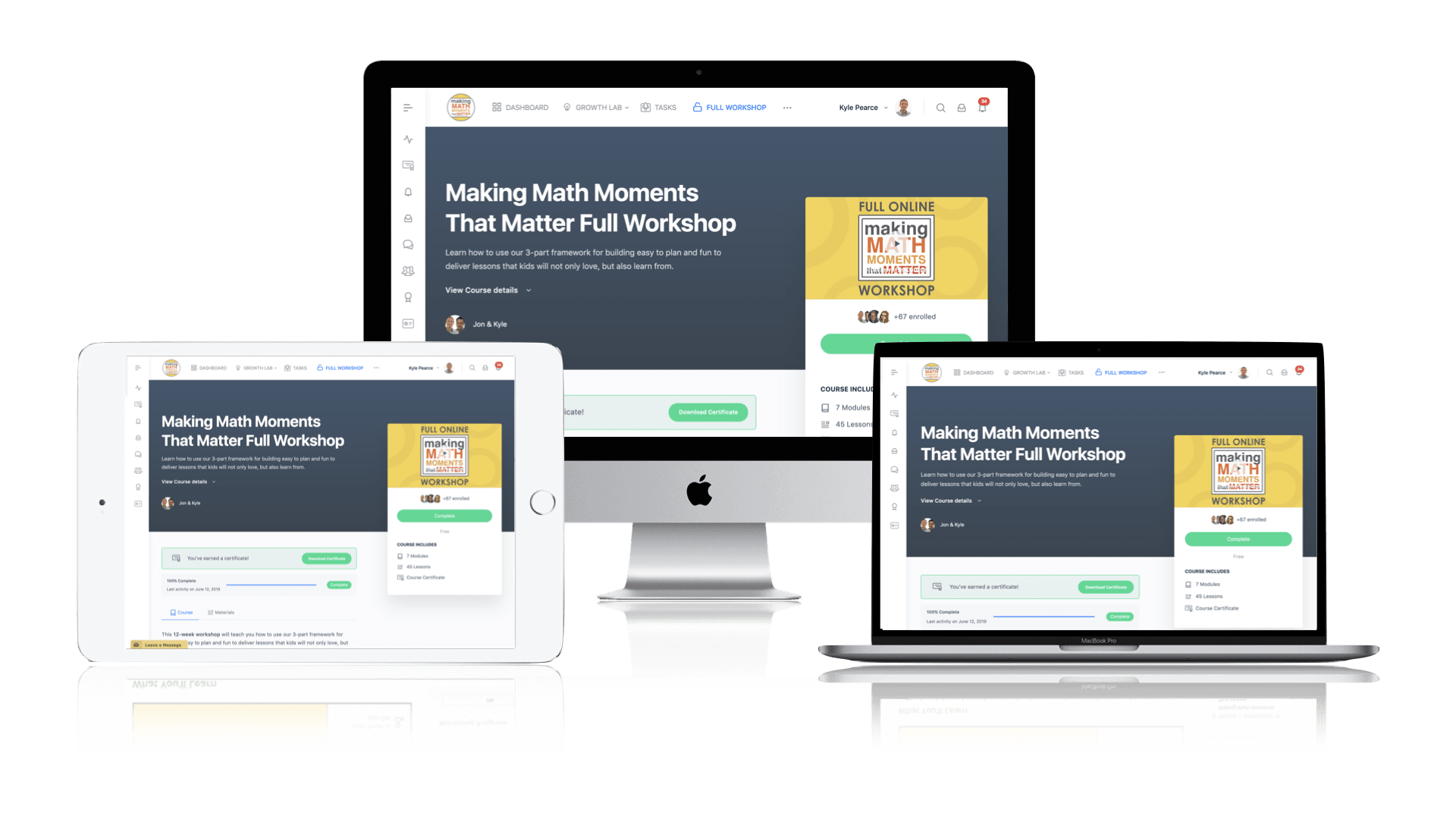
Pedagogically aligned for teachers of K through Grade 12 with content specific examples from Grades 3 through Grade 10.
In our self-paced, 12-week Online Workshop, you'll learn how to craft new and transform your current lessons to Spark Curiosity, Fuel Sense Making, and Ignite Your Teacher Moves to promote resilient problem solvers.
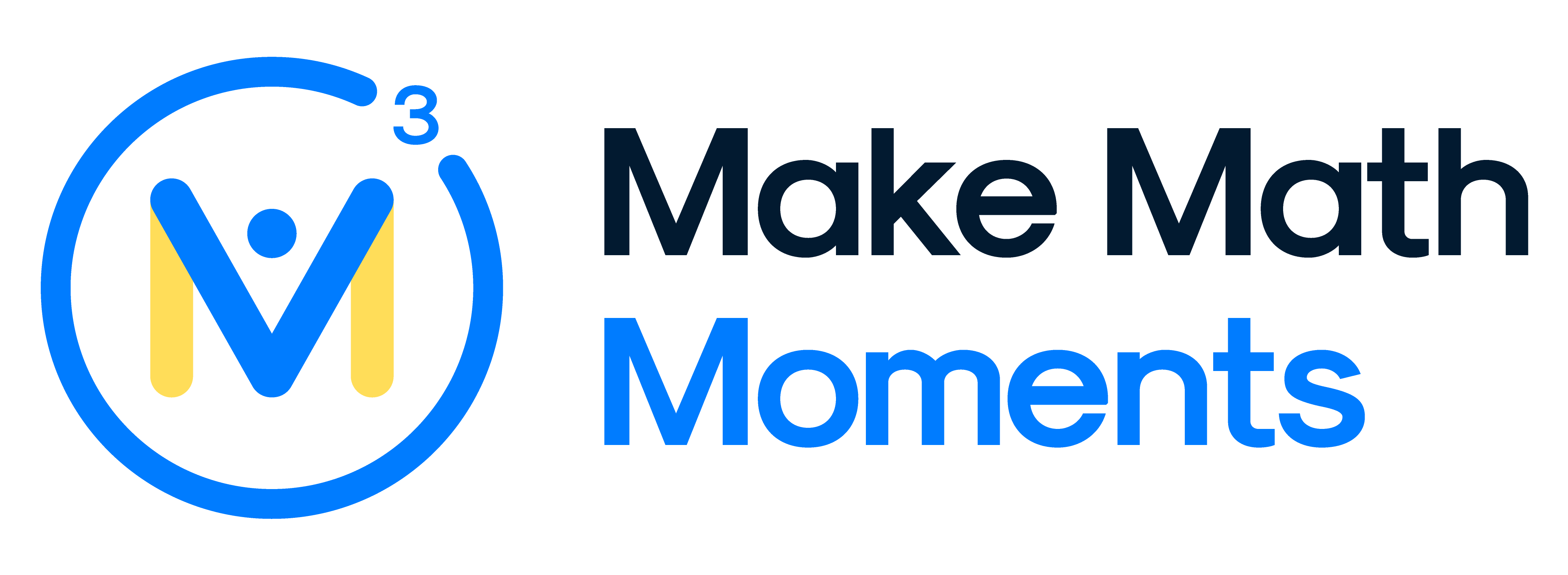
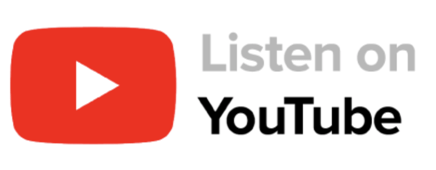


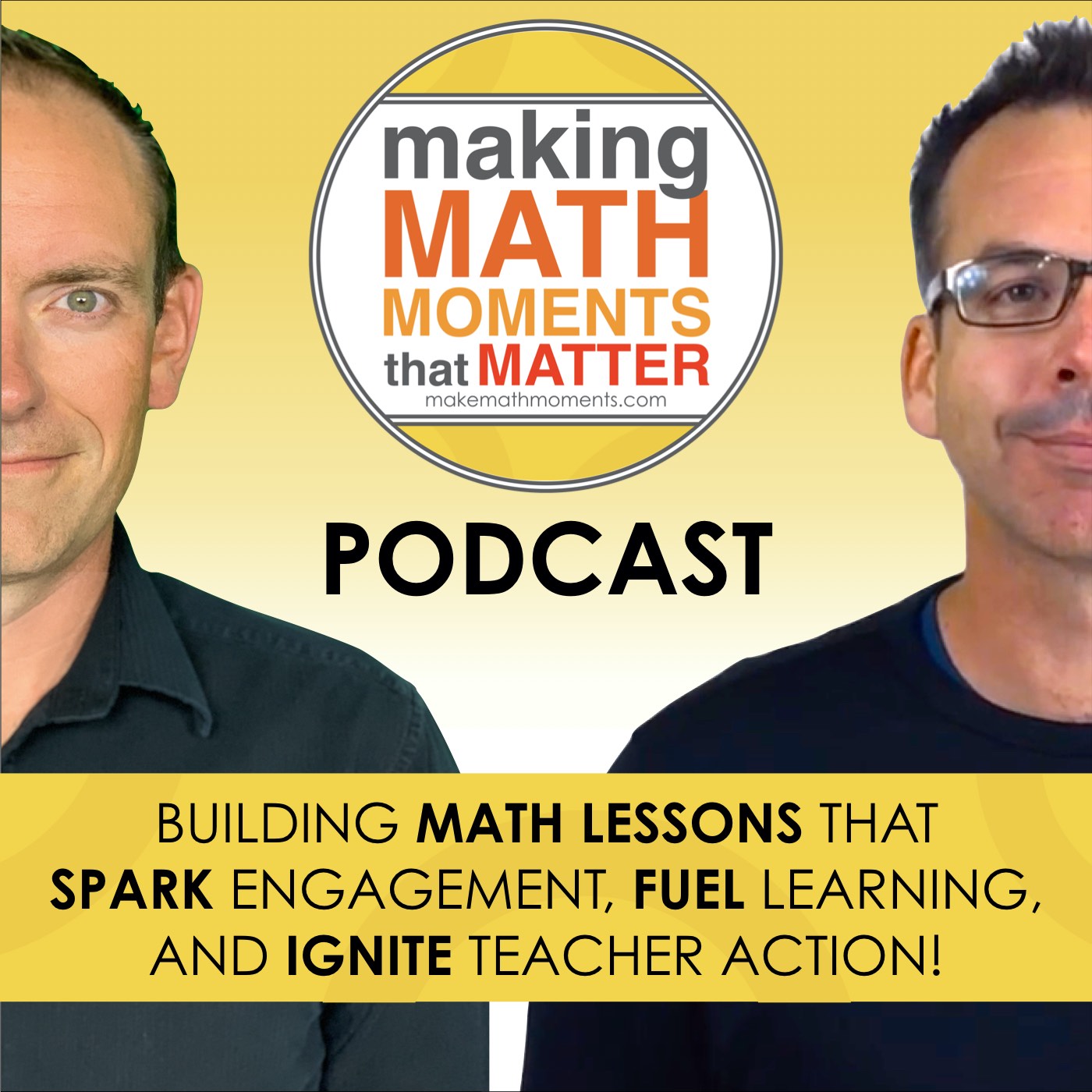
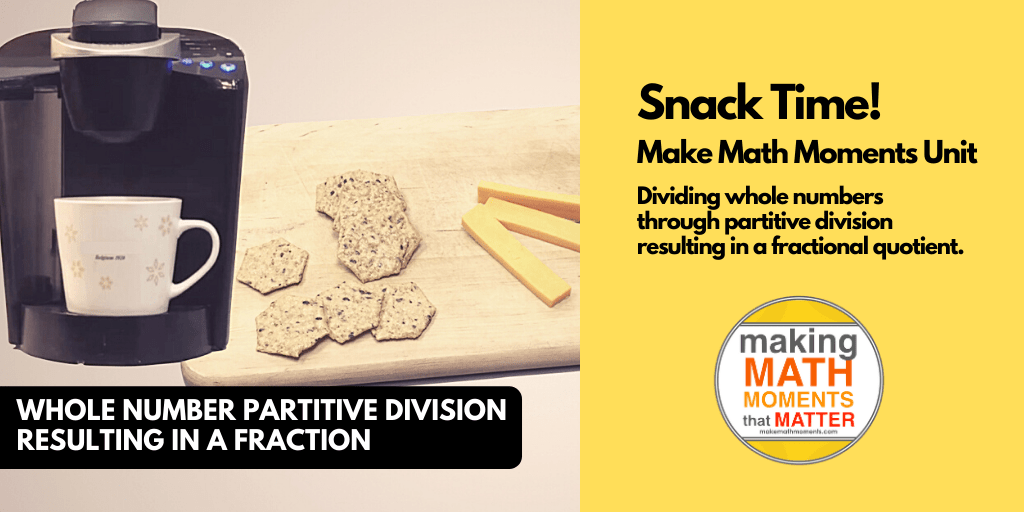
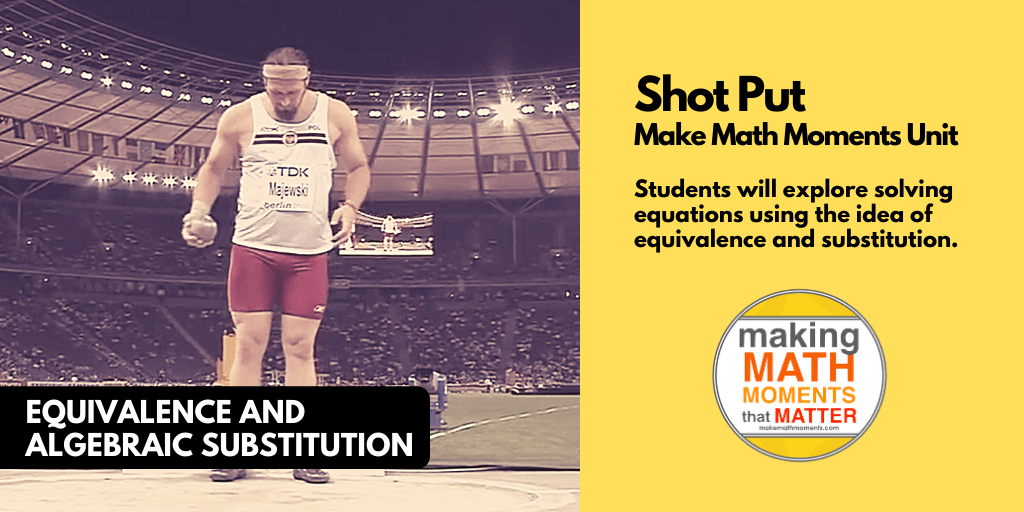
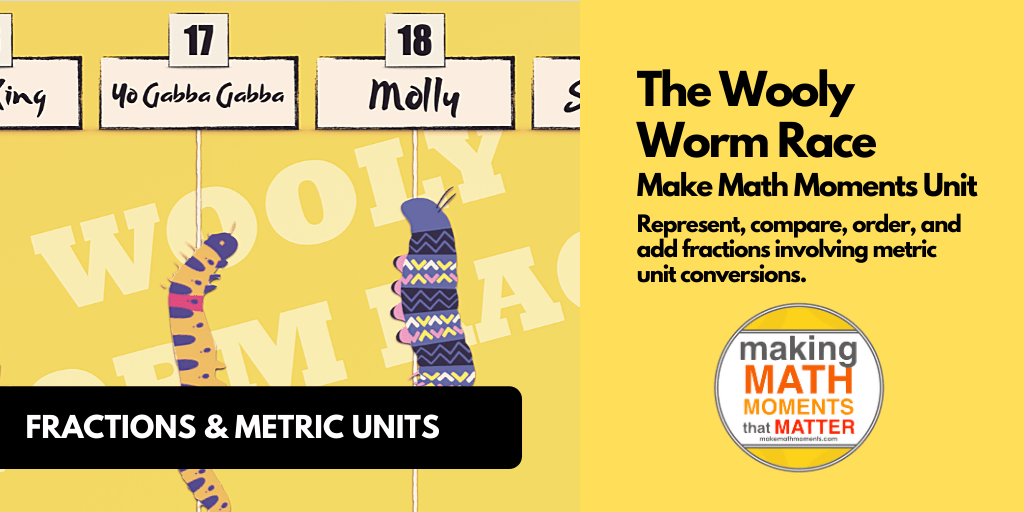
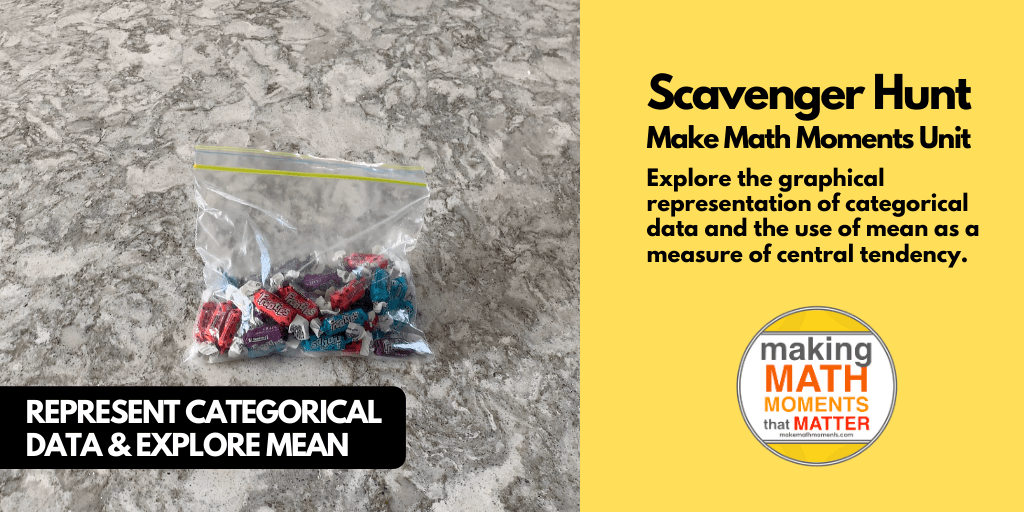
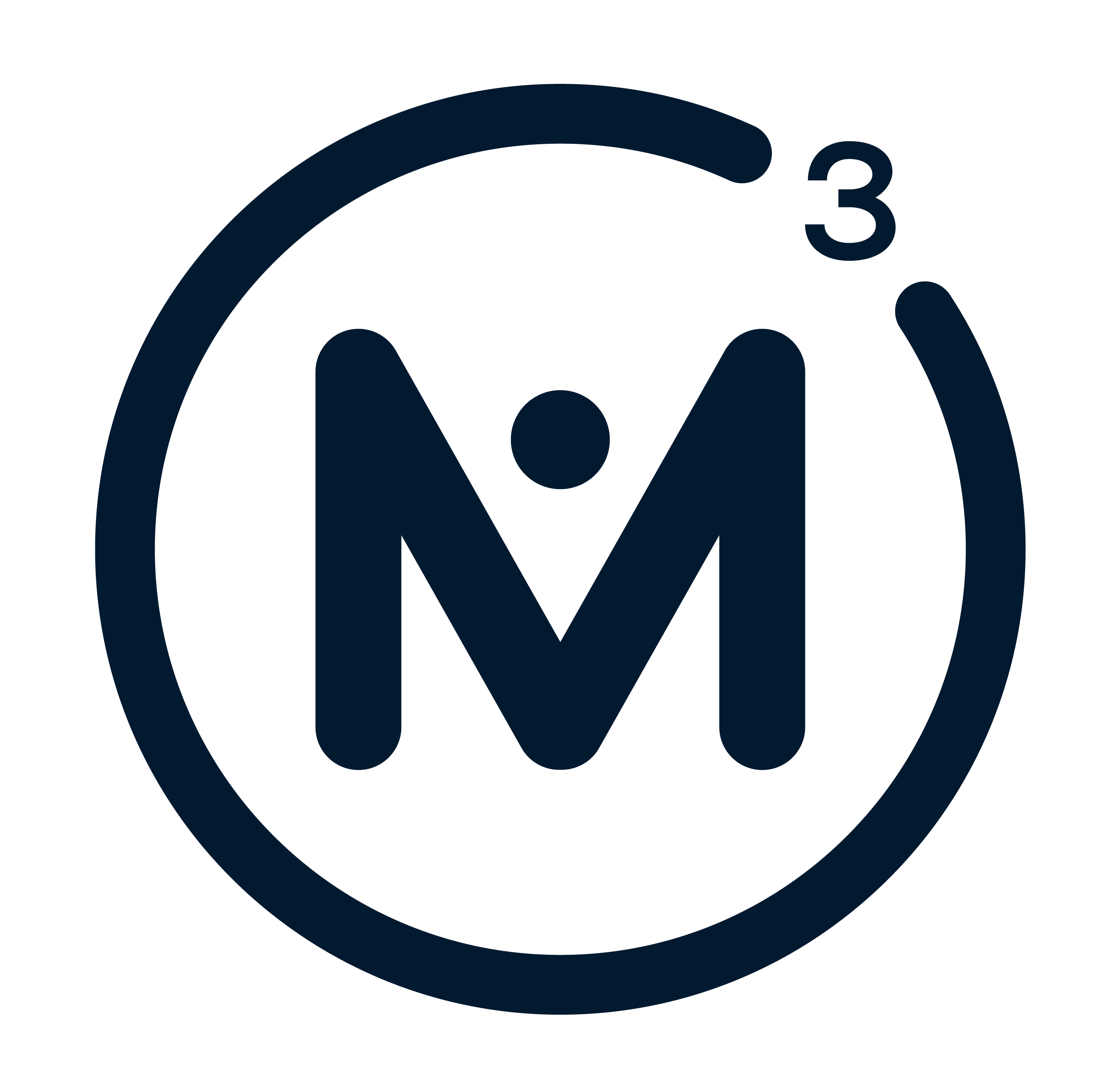
0 Comments